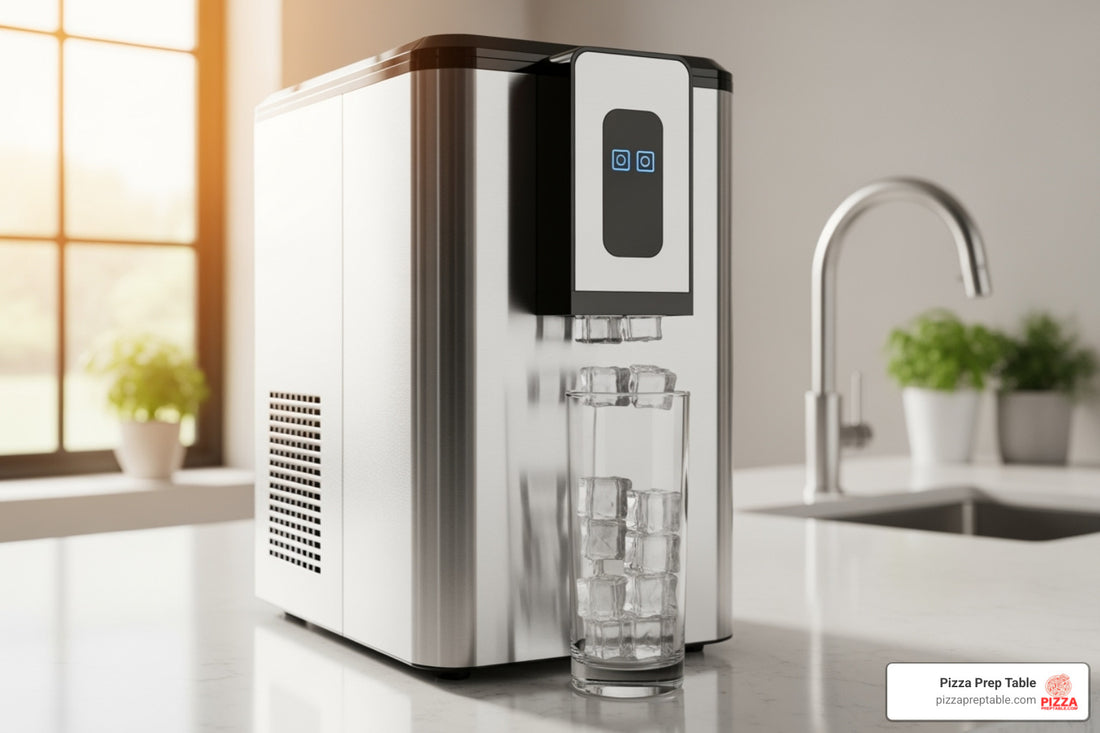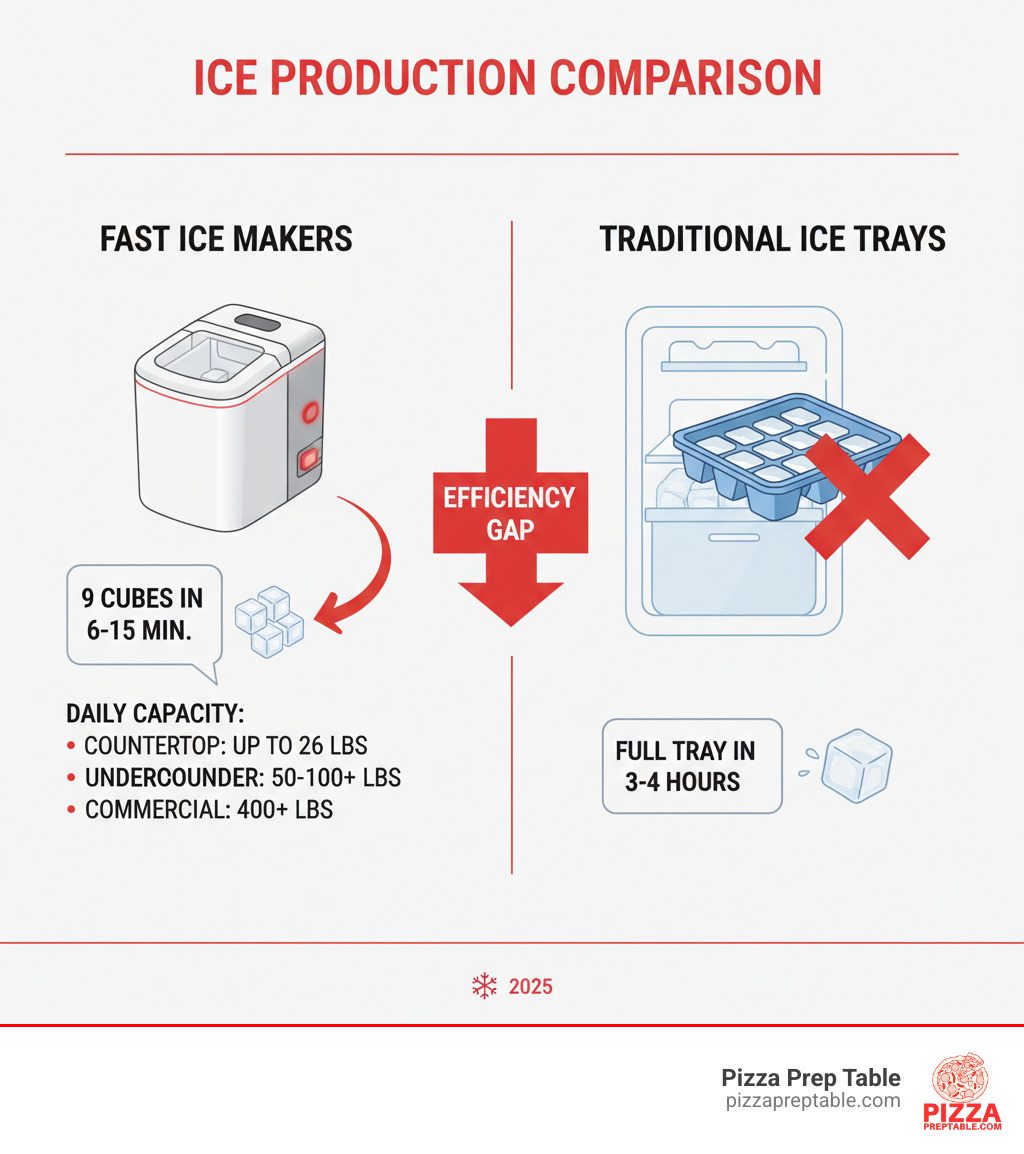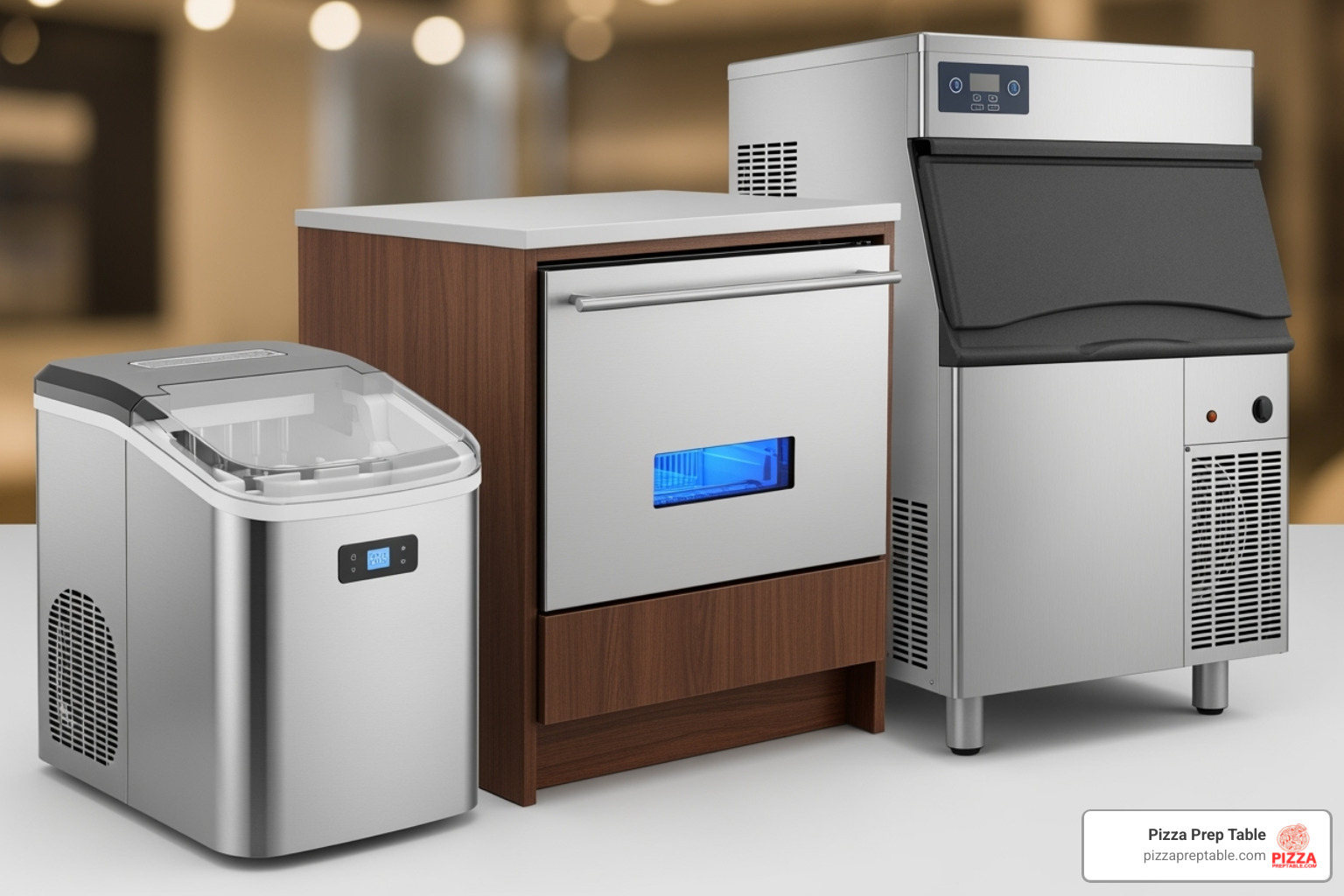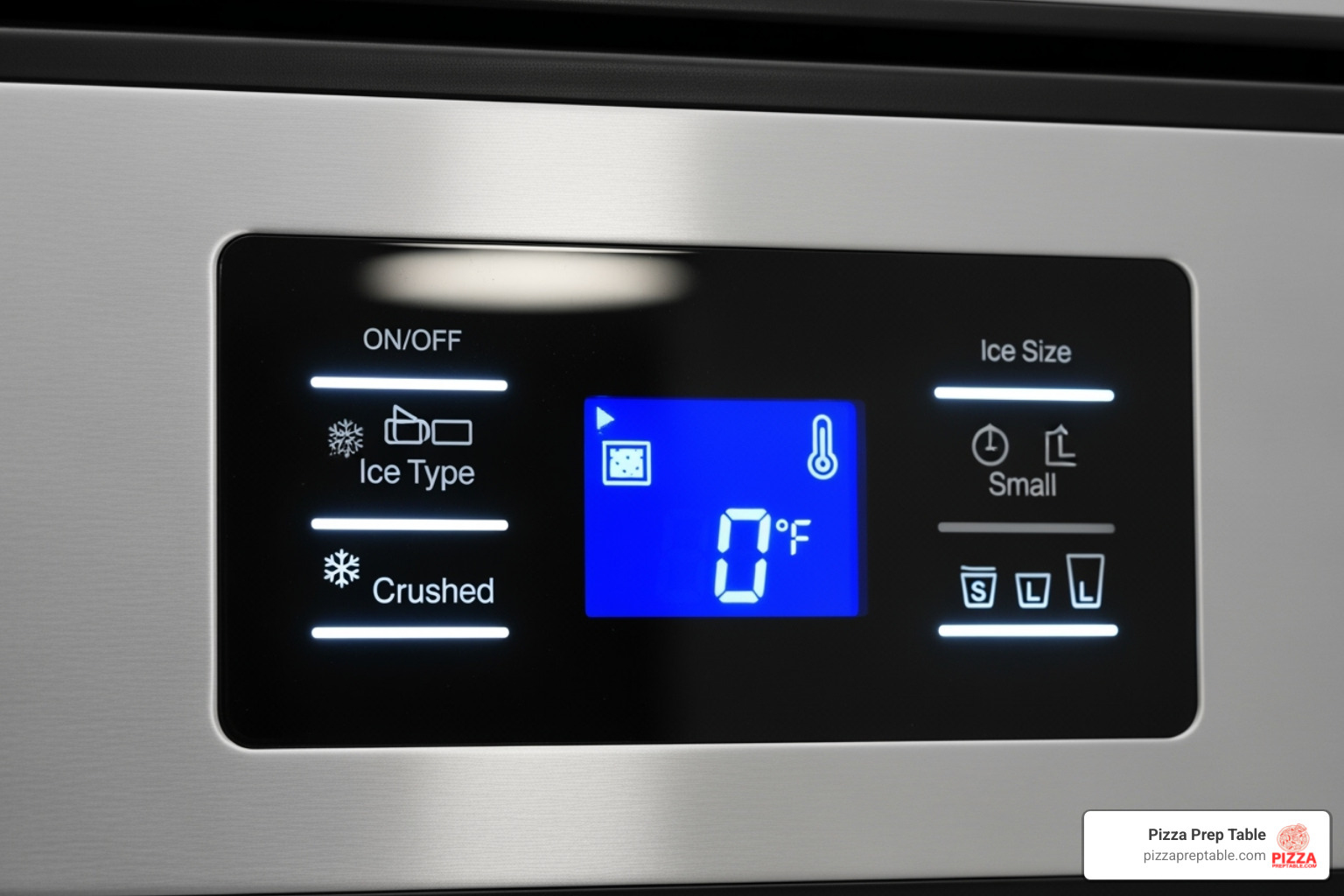
An Essential Guide to Choosing the Best Ice Maker
Share
Why Ice Makers Are Essential for Modern Kitchens
Ice makers have become essential appliances, offering a convenient solution to the common frustration of empty or stale ice trays. Instead of waiting hours for a freezer tray, these machines produce fresh ice on demand, with some churning out batches in as little as 6 minutes.
Types of Ice Makers:
- Portable Countertop - No plumbing, $60-$500, up to 26 lbs/day
- Undercounter/Built-in - Permanent installation, $1,500-$4,000+, higher capacity
- Commercial - High-volume production, 400+ lbs/day, $2,500-$13,000+
Key Benefits:
- Fast production - Ice ready in 6-15 minutes vs. hours with trays
- Consistent supply - No more running out during busy periods
- Various ice types - Nugget, bullet, clear cubes, and flake ice options
Whether you're running a pizzeria dealing with lunch rushes or managing a restaurant where cold beverages are crucial, the right ice maker can transform your operation. These machines range from compact countertop units to commercial powerhouses that produce hundreds of pounds daily.
I'm Sean Kearney, and my experience in restaurant equipment sales has shown me how the right ice makers can dramatically improve kitchen efficiency. From helping small cafes to outfitting large restaurant chains, I've seen how proper ice production impacts business success.

Understanding the Different Types of Ice Makers
Choosing the right ice maker requires matching the unit to your space, volume needs, and budget. Whether for a busy pizzeria or home use, there's an ice maker designed for your situation.

The main differences come down to installation, capacity, and intended use. Let's break down the options.
Portable Countertop Ice Makers
These versatile units are popular for their simplicity. Portable countertop ice makers don't need plumbing—just fill the reservoir with water, plug it in, and you'll have ice in minutes. Their flexibility makes them ideal for backyard parties, RV trips, or small apartments.
The compact design saves counter space, and most are light enough to move easily. You'll find great options from brands like Chefman and AGLUCKY that deliver quality ice without fuss.
Price-wise, they are the most budget-friendly option, typically $60 to $500. The AGLUCKY Countertop Ice Maker starts around $60, while the Iceman by Chefman is about $145. Other solid brands include Ecozy, Magic Chef, and Frigidaire Professional.
Most produce ice in 6 to 13 minutes and can make 26 to 44 pounds daily, which is ample for most families. The Chefman model, for example, produces 26 pounds per day.
Undercounter & Built-in Ice Makers
For a seamless, professional look, undercounter and built-in ice makers integrate directly into your cabinetry. These units connect to your water line and drain, eliminating manual filling. Once installed, they provide a constant supply of fresh ice.
Their higher capacity is a major benefit, with most producing 35 to 50 pounds daily and featuring larger storage bins. KitchenAid's 15-inch and 18-inch models can produce 50 pounds, perfect for entertaining.
Installation requires a water line and drain, so professional help is recommended. A built-in ice maker ensures you always have fresh ice, much like an undercounter refrigerator with a glass door keeps beverages chilled and ready.
Expect to invest $1,500 to over $4,000. A KitchenAid 15-inch built-in model is around $2,738. Brands like KitchenAid, Summit Appliance, and Whirlpool are leaders in this category.
Commercial Ice Makers
Commercial ice makers are heavy-duty machines designed for restaurants, bars, and pizzerias that require massive volumes of ice daily. Reliable ice production is critical to business success, whether for chilling drinks or preserving ingredients.
These machines produce 400+ pounds daily. They come in two main styles: Modular units, which separate the ice-making head from the storage bin for flexible configurations, and Freestanding units, which combine both into a single package.
The SIMZLIFE 400 lb. Commercial Ice Maker is a prime example, producing 400 pounds of ice in 24 hours with a 250-pound storage bin, enough to keep a busy restaurant running smoothly.
Pricing reflects their commercial-grade build, typically $2,500 to $13,000+. The SIMZLIFE model is currently $1,299, while a Thor Kitchen 15-inch built-in is $1,899. Industry leaders include Manitowoc, Scotsman, Brema, and SIMZLIFE.
For businesses managing upfront costs, we offer solutions like ice machine leasing. Just as we help clients explore commercial fridge options, the right ice machine is essential for success.
Key Features to Consider Before You Buy
Once you've chosen a type of ice maker, it's time to compare specific features. Understanding these details will help you select a machine that meets your expectations.

Ice Production Rate and Storage Capacity
Daily yield is the most important metric, indicating how many pounds of ice the machine can make in 24 hours. Home countertop models typically produce 22 to 44 pounds per day. For example, the Iceman by Chefman yields 26 pounds, while the Ecozy Portable model makes 44 pounds. Commercial units produce hundreds of pounds daily.
Speed of first batch is also crucial, ranging from 6 to 15 minutes. The Iceman by Chefman is fast at 6 minutes, ideal for immediate needs. Also, consider the ice basket capacity, which is typically 1-3 pounds for countertop models. You'll need to transfer ice to a freezer for long-term storage. Most units have an auto-off function that stops production when the basket is full or the water is low.
Ice Shape and Quality: More Than Just a Cube
The shape and quality of ice affect your beverage experience. Nugget ice, the soft, chewable ice popularized by restaurants, is a fan favorite. It absorbs flavors well, making it ideal for sodas and cocktails. The GE Profile Opal 2.0 and Ecozy Countertop Nugget Ice Maker specialize in this type.
Bullet ice, a hollow, cylindrical shape, is produced by most portable ice makers. It chills drinks quickly without melting too fast. Brands like Chefman and AGLUCKY have perfected this shape, often offering multiple sizes.
Clear or gourmet cubes are dense, slow-melting cubes perfect for high-end spirits where minimal dilution is desired. Luma Comfort is a brand known for this premium ice. Flake ice is another option, primarily used in commercial settings for food displays.
Size, Noise, and Energy Consumption
Practical considerations like size and noise are important. Always measure your available space. The compact Iceman by Chefman is 12" x 9" x 12.75", while the GE Profile Opal 2.0 is larger at 17.5" x 13.5" x 16.5".
Noise level can be a factor, especially in quiet environments. Some models, like the Luma Comfort Clear Ice Maker, run quietly, while others are louder. The GoveeLife Smart model, for instance, has loud, non-adjustable alerts.
Energy consumption is another consideration, particularly for commercial units. Look for Energy Star ratings, which indicate more efficient operation. The Maxx Ice MIM250 commercial unit, for example, uses 9.4 kW·h per 100 pounds of ice.
Essential Convenience Features
A self-cleaning function is a highly valuable feature that flushes out mineral deposits and keeps the machine hygienic with minimal effort. Models from Ecozy and LIVINGbasics include this function.
Water source is simple: countertop models require manual refilling, while built-in and commercial units connect to a water line for continuous operation.
Smart features like Wi-Fi connectivity are becoming more common. The GE Profile Opal 2.0 lets you schedule ice production from your phone. The GoveeLife Smart model also offers connectivity. Most ice makers include an ice scoop and removable basket, but it's always good to confirm what's included.
Our Top Picks: The Best Ice Makers of 2025
After extensive testing and years of experience helping restaurants, I've identified the ice makers that best combine performance, value, and convenience. These standout machines deliver what you need, when you need it.
Best Overall: Iceman by Chefman Dual-Size Countertop Ice Maker
The Iceman by Chefman is my top recommendation for most people because it's fast, reliable, and straightforward. This compact unit produces up to 26 pounds of ice daily and offers two different bullet ice sizes.
Its key feature is its lightning-fast production speed, with the first batch ready in just six minutes. The dual-size option is also useful, providing smaller cubes for quick chilling and larger ones for slower melting.
At around $145, it offers an excellent balance of quality and affordability. Its compact design won't overwhelm your counter, and it's light enough to store easily. For most homes, this ice maker is an ideal choice.
See the Iceman by Chefman on Amazon
Best Value: AGLUCKY Countertop Ice Maker
The AGLUCKY Countertop Ice Maker proves that you don't need to spend a lot for good ice. While the first batch takes around 18 minutes, this machine delivers impressive value at just $60.
This budget-friendly ice maker produces 26.5 pounds of ice daily and features simple, easy-to-use controls. Its compact design is perfect for small apartments, dorms, or anyone new to countertop ice making.
A self-cleaning function adds to its value by simplifying maintenance. If you're looking for your first ice maker or a reliable backup, the AGLUCKY offers solid performance at an unbeatable price.
Check price for the AGLUCKY model
Best Splurge for Nugget Ice: GE Profile Opal 2.0
For fans of soft, chewable nugget ice, the GE Profile Opal 2.0 brings the restaurant experience home. This isn't just an ice maker; it's a luxury appliance that's also a conversation starter.
Wi-Fi connectivity allows you to schedule ice production from your phone, so fresh nugget ice is always ready. It produces up to 38 pounds of ice daily, and a convenient side tank provides extended water capacity, keeping up with even the most ice-obsessed households.
At around $566, it's a significant investment, but for nugget ice enthusiasts, it's worth it. The sleek design and smart features add a level of convenience that justifies the price. If "the good ice" is a must-have, this is your machine.
View the premium GE Profile Opal 2.0
Best for High-Volume Commercial Use: SIMZLIFE 400 lb. Commercial Ice Maker
For pizzerias and restaurants, running out of ice during a rush is not an option. The SIMZLIFE 400 lb. Commercial Ice Maker is built for high-pressure environments, delivering a massive 400 pounds of ice in 24 hours.
This freestanding unit includes a 250-pound storage bin, allowing you to build a reserve for peak hours. Its robust construction is designed to handle the constant demands of commercial use.
At approximately $1,299.99, it offers serious value for businesses that rely on a consistent ice supply. For those concerned about upfront costs, flexible solutions like ice machine leasing can help manage expenses.
Care and Troubleshooting for Your Ice Maker
Proper maintenance ensures your ice maker runs smoothly and produces great-tasting ice. Understanding how it works and how to fix common issues will keep you prepared.
How Do Ice Makers Work?
Ice makers operate on a simple but ingenious cycle. A water pump moves water from a reservoir or water line to a set of super-chilled freezing prongs. Water freezes onto these prongs, forming cubes.
The refrigerant cycle, similar to a refrigerator's, is what makes the prongs cold. Once the ice is formed, a brief warming period—the harvest process—releases the cubes into the storage basket. Any melted ice is collected and recycled back into the reservoir to be frozen again, thanks to a meltwater recycling system. Sensors automatically stop production when the basket is full or the water is low.
Cleaning and Maintenance Best Practices
Regular cleaning is key to preventing funky tastes and mineral buildup. A good rule of thumb is to clean your machine every one to two weeks, or more often if you have hard water.
To clean, unplug the unit and empty it. Wash the interior with warm water and mild detergent. To descale mineral deposits, run a few cycles with a solution of water and a tablespoon of white vinegar or lemon juice. Afterward, drain the solution, rinse thoroughly, and run a few cycles with fresh water to flush out any lingering taste.
Many modern ice makers have a self-cleaning cycle, which is a convenient feature for regular maintenance, but it doesn't replace occasional manual cleaning.
Pro Tip: Using filtered water results in clearer, better-tasting ice and significantly reduces mineral buildup, extending your machine's life. For built-in units, remember to regularly replace your filters for refrigerator ice makers.
Common Troubleshooting Tips
Before calling for service, try these simple fixes for common problems.
- Unit's not making ice: Check if the "ADD WATER" light is on. Also, ensure the room temperature is between 50°F and 105°F, as extreme temperatures can affect performance.
- Ice tastes like plastic: This usually means the machine needs a thorough cleaning. Use the vinegar solution method described above.
- Cloudy ice cubes: This is normal for most fast-producing ice makers. Rapid freezing traps air bubbles in the water, creating a cloudy appearance. It is safe and does not affect taste.
- Unit won't stop making ice: The infrared sensor that detects a full basket might be obstructed or affected by direct sunlight. Try moving the machine to a shadier spot and check for any ice blocking the sensor.
Always prioritize safety. We recommend checking for appliance safety recalls, as some models have been recalled for safety issues.
Frequently Asked Questions about Ice Makers
It's natural to have questions when shopping for an ice maker. Here are answers to the most common ones I encounter.
Will a countertop ice maker keep ice frozen?
No, most countertop ice makers do not function as freezers. The ice basket is insulated, which slows melting, but it is not actively refrigerated. Think of it as an ice factory, not a storage unit.
When ice melts, the meltwater is recycled back into the reservoir to make new ice. This is an efficient design, but for long-term storage, you should transfer fresh ice to your freezer.
The exceptions are some high-end undercounter and commercial ice makers that have actively refrigerated storage bins.
How often should I clean my ice maker?
For optimal performance and taste, clean your ice maker every one to two weeks. If you use it daily or have hard water, weekly cleaning is recommended. Using filtered water can reduce the frequency of deep cleanings.
Always clean the machine before storing it for an extended period and again before its first use after storage. For refrigerator units, regularly changing filters for refrigerator ice makers is also crucial for maintaining ice quality.
Why are some ice makers so expensive?
The price of an ice maker is influenced by several factors, explaining the wide range from under $100 to over $4,000.
- Specialized Ice Types: Making nugget ice requires more complex engineering than standard bullet ice, driving up the cost.
- Durability and Capacity: Commercial-grade components are built for high-volume, continuous use, increasing durability and price. Higher production capacity also adds to the cost.
- Advanced Features: Smart features like Wi-Fi connectivity and actively refrigerated storage bins add significant complexity and expense to the manufacturing process.
Essentially, you are paying for capacity, ice type, durability, and convenience. A basic model may last a few years with moderate use, while a commercial unit is an investment designed to last for a decade or more.
Conclusion: Find Your Perfect Chill
From compact countertop models to high-capacity commercial units, there is an ice maker to solve the universal frustration of running out of ice. Whether for a backyard barbecue, a busy pizzeria, or a perfect evening cocktail, the right machine is out there.
By considering the key factors—capacity, ice type, size, and features—you can find an appliance that improves your daily life or business operations. A home entertainer might splurge on a GE Profile Opal 2.0 for its nugget ice, while a café owner will need the reliable output of a commercial model like the SIMZLIFE 400 lb.
Today's ice makers have evolved with features like smart connectivity and self-cleaning cycles that add significant convenience. For homeowners, this means an end to frantic ice tray refills. For business owners, it ensures smooth operations and customer satisfaction.
At Pizza Prep Table, we know that every piece of equipment matters. The ice maker that chills your drinks is just as important as the prep tables that organize your ingredients. When you're ready to equip your commercial kitchen with reliable solutions, explore our collection of commercial pizza prep tables. Success lies in having the right tools for the job.
Here's to never running out of ice again!
